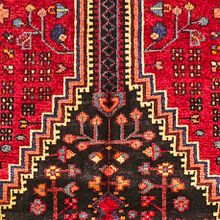Touserkan Rug
| Touserkan Rug | |
|---|---|
 Design of Touserkan Rug (Rugman) | |
| General information | |
| Name | Touserkan Rug |
| Original name | قالی تویسرکان |
| Alternative name(s) | Touserkan Carpet |
| Origin | |
| Category | Village |
| Technical information | |
| Common designs | Medallion, Geometric |
| Common colors | Navy Blue, Blue, Ivory, Beige |
| Dyeing method | Natural, Synthetic |
| Pile material | Wool |
| Foundation material | Cotton |
| Knot type | Symmetrical (Turkish) |
Touserkan rugs are produced by Kurdish nomads living in northwestern Iran. Time seems to have stood still for these people. They have not been influenced by modern conveniences and technology, preferring instead to live simple lives in the traditions of their ancestors. The women of the tribe weave area rugs on crude handmade looms that are compact and easy to transport when the time comes to move on. Many of the area rugs are woven for their personal use as sleeping mats and floor coverings in addition to being their main source of income. The women who weave these magnificent area rugs are most diligent and meticulous. It is not uncommon for a single rug to take months of concentrated effort. Touserkan rugs are created using the single weft Hamadan weave, also known as Sennah Baft, indicative of the region.
History
See also
| Search for Touserkan Rug on Wikipedia. |
References
Bibliography
- Abraham Levi Moheban. 2015. The Encyclopedia of Antique Carpets: Twenty-Five Centuries of Weaving. NewYork: Princeton Architectural Press.